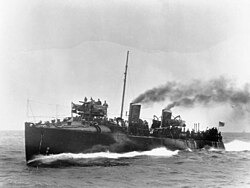SMS D 10
|
The similar-looking sister boat HMS Fame of the Royal Navy
|
||||||||||||||||||||
|
||||||||||||||||||||
|
||||||||||||||||||||
|
||||||||||||||||||||
|
||||||||||||||||||||
D 10 was a torpedo division boat of the Imperial Navy , which wasprocuredin Great Britain as a guide boat for torpedo boats and for comparisonpurposes.
Torpedo division boats
The command boats of torpedo boat flotillas of the Imperial Navy, known as division boats, represented a forerunner of the later destroyers in terms of size and armament support with their reinforced armament.
At the end of the 19th century, a torpedo boat division usually consisted of one division boat and eight torpedo boats. Instead of the usual designation from the first letter of the shipyard and a consecutive number as with normal torpedo boats, the number was prefixed with a D for division boat .
history
Construction and commissioning
The boat was ordered in the budget year 1896 by the Reichsmarineamt as the sister ship of the British Thornycroft 30 knotter class , which was highly praised for its speed . The reason for the purchase was a performance and construction comparison with the last self-made SMS D 9 .
The construction progress was monitored at the Thornycroft shipyard in Chiswick by officials of the Reichsmarinamt and regularly reported to the Secretary of State Tirpitz and the torpedo inspection. It was interesting for the German side that it was surprisingly found how the high test drive speeds determined on the British side came about: The British boats were neither fitted with weapons for the test drive, nor were they driven with full supplies or full crew. After being taken over by the Imperial Navy, the D 10 carried out the test drives in accordance with German regulations and only achieved just under 27 knots instead of the 30 knots reported for the British sister ships. The long-term sustainable speed was even reduced to 22 to 23 knots and was thus on the level of D 9 , which, however, was much more seaworthy. Subsequently, the chimneys had to be increased to D 10 and the bow torpedo tube removed. In the Imperial Navy, the boat was nicknamed Schlingerpott due to its poor seaworthiness .
Differences to the British D-Class
Despite the same hull, there were structural differences to the British sister boats of the D-class due to the German operational doctrine . The bridge was not placed above the turret with the main gun, but stood directly in front of the front chimney. The armament was different: Whereas in the British boats according to that use doctrine as Torpedoboot destroyer the arming of a 12-pounder 76 mm-L / 40 -Mk.I gun on the back , five 57 mm / L40-6pdr guns and two 18 inch torpedo tubes existed, the German boat had five 5.0 cm torpedo boat cannons L / 40 for destroyer defense , as well as an additional 45 cm underwater bow torpedo tube. The main mast on the German boat was between the two funnels, while on the British D-Class it was in front of the front smoke outlet.
Mission history
After the deep-sea torpedo boat, later referred to as the large torpedo boat , had already been introduced into the navy with SMS S 90 from 1898 , D 10 was used as a tender for the submarine acceptance commission from 1907 due to its inadequacies . After the start of the war in 1914, it served briefly in coastal protection under Lieutenant Hans Adam and was then assigned to the 5th submarine flotilla as an escort ship. After the war it was used as a houseboat for a short time from 1919 on, before it was struck from the fleet list on July 28, 1922, taken out of service and then scrapped in Wilhelmshaven.
SMS D 10 was the last torpedo division boat acquired by the Imperial Navy. Such special driver vehicles were no longer procured for the following ocean torpedo boats from the S 90 series . Instead, individual boats were given additional facilities and accommodation for the flotilla resp. Semi-flotilla staff.
Individual evidence
- ↑ Gröner Vol. 2 p. 42
See also
literature
- Maurice Cocker: Destroyers of the Royal Navy, 1893-1981 , Ian Allen 1983, ISBN 0-7110-1075-7
- Harald Fock: Black journeymen , Volume 1: Torpedo boats until 1914 , Koehlers Verlagsgesellschaft, Herford 1979, ISBN 3-7822-0193-0 .
- Harald Fock: Black journeymen , Volume 2: Destroyers until 1914 , Koehlers Verlagsgesellschaft, Herford 1981, ISBN 3-7822-0206-6 .
- Harald Fock: Z-before! , Volume 1: International development and war missions of destroyers and torpedo boats 1914 to 1939 , Koehlers Verlagsgesellschaft, Hamburg 2001, ISBN 3-7822-0762-9 .
- Erich Gröner : The German warships 1815-1945 Volume 2: Torpedo boats, destroyers, speed boats, minesweepers, mine clearance boats , Bernard & Graefe, Bonn 1998, ISBN 3-7637-4801-6 .
- David Lyon: The First Destroyers , 1996, ISBN 1-84067-364-8
- Edgar J. March: British Destroyers , A History of Development 1892-1953 , Seeley Service & Co, London 1966.
